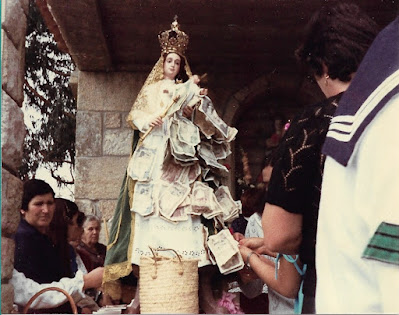This being summer, despite the weather, festivals are going on all over the place. Or, they would be, if it weren't for Covid. Today is the feast day of the Virxe dos Milagros, or the Virgin of Miracles over in the next parish of O Araño, my father's parish and where cousins of mine live. It's also the pilgrimage of the Vikings across the Ulla River in Catoira.
The Virgin of Miracles is another manifestation of the Virgin Mary. There are a few places that celebrate that aspect of her, the biggest in our region being the festival at the Sanctuary in Baños de Molgas, Ourense, at the beginning of September. The name, Virxe dos Milagros, can refer to different aspects of the Virgin. One is because she's simply who she is, the Mother of God, another is the aspect of the Virgin of Guadalupe, with the miracle of her statue being found, or the appearance of her image on the cape of an Indian in Mexico. Another has the feast day at the end of November, and refers to the miraculous medal the Virgin asked St. Catherine Labouré to create and have struck, in 1832 in Paris, which was later claimed to have miraculously cured some people in the following cholera outbreak. The one in O Araño must refer simply to the Virgin and the person she is, since it's celebrated in August, which is when the Feast of the Assumption falls.
She's not even the patron saint of the parish, that honor being held by St. Eulalie, whose feast day falls in December. But, there's a small chapel near the church, within a carballeira, an oak grove, where Masses are celebrated in honor of the Virgin every first Sunday in August. Now, right next to the grove and the parish church, on the other side of a lane, are the remains of a hill fort over two thousand years old. Given the fact that later Christian priests decided to re-dedicate sacred groves to Christian saints, it's not a stretch of the imagination to believe that the area has been held sacred for thousands of years, for one reason or another. Possibly, our ancestors celebrated the Earth Mother there, once upon a time.
 |
| The doll of contention, 1974. |
These days, Masses begin at eight in the morning and continue until the High Mass, at one. I remember going when I came here on vacation in my childhood, standing with the crowds in the hot August sun at the High Mass, waiting for the priest to finish, as well as the procession, so my mother would buy me the doll I wanted from one of the stalls that had set up shop nearby. I later left that doll to my small cousin, against my will, when we left for Boston in September. Another year, I got a toy guitar, and my small cousin got another one, so there was no question of me giving her mine. There would be bombas de palenque at the end of the procession, fireworks without the pretty colors, just booming sound that ripped through my stomach and scared the birds sheltering from the sun in the trees. The Virgin would be taken in procession, covered in money notes. I remember one year, she had a hundred dollar bill prominently affixed to her gown. After, we would buy a round, dark green watermelon, so unlike those we used to buy at Haymarket on Saturdays, from the truck parked by the side of the lane, awaiting the Mass goers. We would take it down to my grandmother's house, where we were invited to eat. I still remember sitting at the table in the cool kitchen, eating the sweet, crisp watermelon for dessert.
In the evening, there would be a band or two, playing until three or four in the morning. My parents and I would go, and so would my older cousins, with my small cousin. We would play and run around the area lit by dim lightbulbs, and the colored lights from the makeshift stage, where the musicians would be belting out the popular tunes of the summer; the English songs massacred to a pulp, the only recognizable part being the music. Neighbors of my small cousin, similar to us in age, would join us as we played hide and seek. We would weave in and out of people standing around, or dancing to the music, and even under the stage, going carefully through the metal pipes holding it up.
I have never been to the Vikings in Catoira. It is supposed to be an enormous melée of people and actors disembarking from Viking ships, simulating the attacks the Torres de Oeste once sustained from the North Men. It's been celebrated since 1961, when a group of men got together and asked themselves, "Why not have a historical reenactment of the Vikings attacking the Torres?" So, they organized everything, and everyone had so much fun, that it continued, year after year.
It's held every year at the Torres de Oeste, the ruins of two towers built to protect the Ulla River from marauders who wanted to sail inland to sack Santiago de Compostela. The name was originally Castellum Honesti, or Honesti's Fort, but time and changing language has mutated the name. Thousands of people throng the bridge above that spans the river, watching as the Viking marauders land and terrorize the town folk, though the most dangerous weapon used now is the red wine used to douse everyone. Afterward, there's wine and food for everyone, or everyone who can pay the stalls or who brings their own. There's picnicking in the afternoon, among the ruins and the surrounding marshland. In the evening, there's also music. It sounds like a fun festival to attend, but the pull of family, and the enormous amounts of people, have always managed to stop me from going.
Of course, this is Covid time, and the festivals have changed accordingly. Last night, there was music in O Araño, but the people who attended were few, and they were all sitting in folding chairs, spread out with the required meters. I don't know how the Vikings will roll, because there must be a limit on how many can attend, and the landing with its attack doesn't sound feasible. It's not really worth it, this year, to attend popular festivals, not if you have to fight for a ticket, and then watch your distance and wear a mask because of the numbers of contagion.
When we will be able to live like we used to? I would love to have it be soon, but I doubt it will be.
Life continues.
 |
| A Virxe dos Milagros, 1982. |